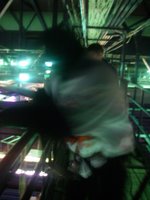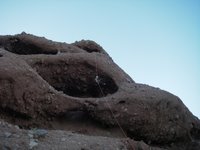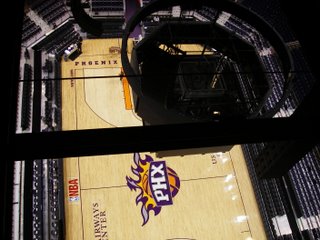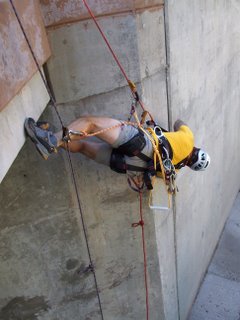You were all salivating, I know. Here it is, as posted on the ACA forums, with all of the public derision to follow. Let loose the hounds. Without further ado:
Englestead and Orderville Canyons, Friday October 6, 2006.
We were aware of the flash flood warning issued and decided to descend Englestead canyon. Hindsight would certainly suggest reconsideration of the decision, but we don’t feel it worthwhile to sit and discuss hypotheticals. Our interest is in presenting an account of the events of the day. The intent of this posting is to describe the decision making process once we were committed and the lessons gleaned from the experience in a hope to facilitate a discussion of the hazards involved in canyoneering and of ways to mitigate the risks created.
Englestead has two extremely committing sections, with a middle section with limited, but definite high ground possibilities. The canyon is normally a 3 or 4 A IV, but as the descent continued, it became apparent that the canyon had flashed the day before, with foam lingering as well as anchors surrounded by debris. In light of the recent precipitation, this should not have been surprising. There were some swims involved, and we should have packed wetsuits. However, the synthetics we had packed were sufficient as long as we kept moving.
We dropped into Orderville canyon at 12:15 PM. We decided to continue down canyon, taking note of all high ground possibilities. We hiked ~2 miles down canyon in 45 minutes. When the sky clouded over and quickly began to sprinkle, we talked about options; when it began to pour, we ran back upstream to the last area of high ground. We found a small overhang and waited underneath, watching the watercourse.
Orderville had an insignificant small brown flow when we entered, and it quickly increased volume from the precipitation landing directly in the drainage, but there was no extreme change for about 15 minutes. At ~1:40 PM we heard the sound - train, plane, thunder, or that suck-straw the dentist uses magnified a million-fold. Around the bend came the curtain, followed ~20 seconds later by the head wall, about 2.5-feet higher than the curtain by 8-feet wide. We referenced a rock and watched to notice trends in water flow. It changed tidally, as the flash from each drainage up-canyon reached Orderville and joined the main flood.
At this point, I would like to present some issues to consider. Let’s revisit the rating of Englestead under normal conditions – 3 or 4A IV. The roman numeral denotes that if something goes wrong, you could very well need to spend the night in the canyon. A flash flood could be considered something that goes wrong. Despite the efficiency of the group and the familiarity of the canyon, we should have all had a bivy possibility, along with dry clothing and a means to make hot food. We had some dry clothes, some food and some emergency blankets, but not enough for spending the night comfortably. Packing more of these items would certainly lead to a heavier load through the canyon, but the precautionary principle might be best to use when considering packing for a canyon. Without these means available, being soaking wet and with the temperature dropping, we needed to consider other options.
With Orderville flowing and draining into the Virgin River, hiking down-canyon into a bigger flood was off the table. One viable option considered was a possible exit route from the canyon up to the East Rim. We scouted two routes, and one was a distinct possibility. However, two concerns were present:
1) We did not have the topographic map of the area with us. Once we got up the initial pitch, there existed a possibility that we could become cliffed out. It was impossible to tell. An argument can thus be made, that despite the familiarity with the canyon itself, to ALWAYS carry a topo with you.
2) Exiting the canyon introduced another variable in the trip. Should a rescue become a necessity, being found out of the canyon could take more time.
The resulting decision was to ford up-canyon and up to North Fork Road. Anyone familiar with hiking up Orderville canyon out of Englestead is aware of the upclimb near the boundary of the park. During dry weather, it’s an easy chimney problem. I’ve heard that when muddy, it becomes irritating. I’ve climbed it under low-flow. This obstacle was considered before leaving the relative comfort of the high ground.
At 4:30 PM we began the slog up-canyon. Swift water techniques, e.g., taking advantage of a leader eddy, were often necessary for moving upstream and traversing the watercourse. Climbs up over log jams, backed up by waist deep lakes of debris were tiring. When we passed Englestead canyon around 6:00PM, it was still flowing.
The inevitable arrived – we reached the upclimb. As expected, the normal location for climbing was occupied by a waterfall. Below the waterfall was a significant hydraulic. We attempted a variation of a pack-toss to get a rope fixed up the climb to no avail. The solution that worked involved one of the members of the group tying into the rope, swimming across the hydraulic and climbing the face and gap canyon-left. That person then became a human anchor as the other individuals pulled themselves across the hydraulic with the rope and ascended up the climb. As the last individual got over the obstacle, it was quickly getting dark.
We continued up-canyon in a similar manner, watching the full moon emerge. (Despite the cold, it was quite beautiful. I reckon not too many have seen Orderville canyon flowing under a full moon.) When we passed Birch canyon, it was still flowing. At ~10:00 PM we exited the drainage and hiked up to the road down in the meadow of Orderville canyon. We reached the top of that road at 12:15 AM and were relieved to find an occupied trailer. The owner drove us back to the Ponderosa and we arrived at 1:30 AM. Had that individual not been present, it would have been a very long, cold walk back down North Fork Road.
The group consisted of 3 ACA certified guides and one who has completed all courses through the Rescue class. It is important to realize the combined skill set and experience of the group. I introduce this issue not in an effort to boast of our competency or confidence in handling the situation presented before us that day. The experience was humbling and no one in the group wishes to recreate the experience. However, Rich Carlson has often discussed the ART (Anchors, Rappelling, Technique) of Efficient canyoneering. Proficiency in all aspects of this statement (Efficient is capitalized for a reason), as well as each individual’s self-sufficiency and strong background in swiftwater allowed us to surmount the obstacles presented to us that day.
Describing these events in a public forum is not decided upon lightly. Again, in hindsight, the decision to enter the canyon was incorrect. However, I would like to preempt too much attention being directed at this point. The decision to enter, albeit flawed, was arrived at by weighing the risks involved against our knowledge and experience. These decisions are often made by mountaineers, climbers and paddlers pushing their skills and limits, e.g., by climbing during small weather windows, free-soloing, or paddling 150' waterfalls. Occasionally, even the most experienced individuals do make mistakes and pay dearly for their decisions. No one involved in the trip claims to have a monopoly of knowledge over the subject or to possess an ability to defy or subdue nature’s power.
If showing humility from an experience can prevent even one fatality or injury, or even an unpleasant overnight in a canyon, this post will have been successful. We are all autonomous individuals. It is up to each individual to make decisions that weigh the abilities of every individual in a group as well as the environmental hazards present on each day. In the end, the group must be prepared to face the consequences of those decisions.
That's all. On another note, the links section is being noncooperative with me. We're going to have a heart to heart and see if we can reach an agreement.


























































